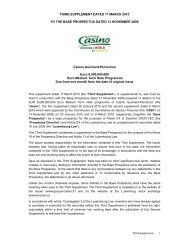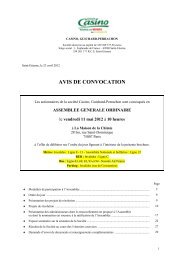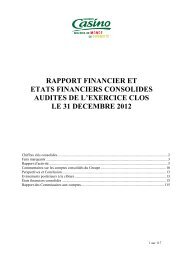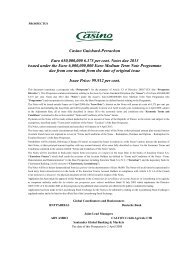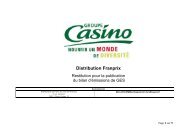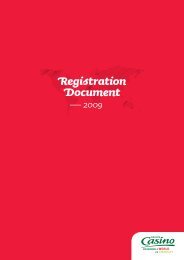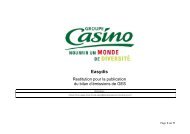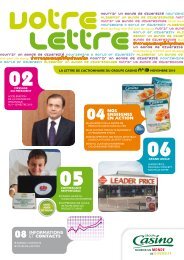2010 REGISTRATION DOCUMENT (3.4 Mo) - Groupe Casino
2010 REGISTRATION DOCUMENT (3.4 Mo) - Groupe Casino
2010 REGISTRATION DOCUMENT (3.4 Mo) - Groupe Casino
Create successful ePaper yourself
Turn your PDF publications into a flip-book with our unique Google optimized e-Paper software.
CONSOLIDATED FINANCIAL STATEMENTSNotes to the consolidated fi nancial statements3Standards and interpretations not adoptedby the European Union on the reporting dateSubject to their final adoption by the European Union, the followingstandards, amendments and interpretations published by the IASB aremandatory for annual periods beginning on or after 1 January 2011(with the exception of the amendments to IAS 12 and IFRS 9).The Group is currently analysing the potential impacts of their firsttimeadoption.■■■■IFRS 9 – Financial instruments: Classification and Measurement,mandatory for annual periods beginning on or after 1 January2013;Amendment to IAS 12 – Deferred Tax: Recovery of UnderlyingAssets, mandatory for annual periods beginning on or after1 January 2012;Amendment to IFRS 7 – Financial Instruments Disclosure, mandatoryfor annual periods beginning on or after 1 July 2011;Annual improvements to IFRSs (6 May <strong>2010</strong>), applicable to theGroup as of 1 January 2011.Note 1.2. Basis of preparation and presentationNote 1.2.1. Accounting conventionThe consolidated financial statements have been prepared using thehistorical cost convention, with the exception of the following:■■land held by companies in the “centralised” scope (historical scopein France) and <strong>Mo</strong>noprix, as well as the warehouse land held byFranprix-Leader Price, for which the fair value at 1 January 2004has been used as deemed cost. The resulting revaluation gainshave been recognised in equity;derivative financial instruments and financial assets available forsale, which are measured at fair value. The carrying amounts ofassets and liabilities hedged by a fair value hedge, which wouldotherwise be measured at cost, are adjusted for changes in thefair value attributable to the hedged risk.The consolidated financial statements are presented in millions of euros.The figures in the tables have been rounded to the nearest millioneuros and include individually rounded data. Consequently, thetotals and sub-totals may not correspond exactly to the sum of thereported amounts.The consolidated financial statements for the year ended 31 December2008 are incorporated by reference.Note 1.2.2. Use of estimatesThe preparation of consolidated financial statements requires theuse of estimates and assumptions that affect the reported amountof certain assets and liabilities and income and expenses, as well asthe disclosures made in certain notes to the consolidated financialstatements. Due to the inherent uncertainty of assumptions, actualresults may differ from the estimates. Estimates and assessments arereviewed at regular intervals and adjusted where necessary to takeinto account past experience and any relevant economic factors.The main estimates and assumptions are based on the informationavailable when the financial statements are drawn up and concernthe following:■■■commercial cooperation fees (see note 1.5.24);impairment of doubtful receivables (notes 19, 21 and 22);impairment of non-current assets and goodwill (see notes 1.5.12and 16);■■■■■■available-for-sale financial assets (see note 19.1);fair values of investment property disclosed in the notes (see note15), as well as the accounting treatment of investment propertyacquisitions. For each transaction, the Group analyses the existingassets and operations to determine whether the acquisition shouldbe treated as a business combination or a separately acquiredasset;deferred taxes (see notes 1.5.31 and 8);non-current assets (or groups of assets) held for sale (see note 10);put options granted to owners of non-controlling interests andcontingent consideration in business combinations (see notes1.5.20 and 28);provisions for liabilities and other operating provisions (see notes1.5.19.2 and 26).Additional disclosures on the sensitivity of goodwill, provisions andput option values are provided in notes 16, 26 and 28.Note 1.3. Impact of accounting changesThe financial information previously published has been adjustedfor the impact of the revised standard IAS 27 – Consolidated andSeparate Financial Statements, which introduced an amendment toIAS 7 – Statement of Cash Flows.The revised versions of IFRS 3 - Business Combinations and IAS27 - Consolidated and Separate Financial Statements are applicableprospectively for financial periods starting on or after 1 January<strong>2010</strong>. Business combinations completed before 1 January <strong>2010</strong> aretherefore not affected and are accounted for using the same methodas that used to prepare the consolidated financial statements at31 December 2009.The two revisions introduce significant changes to the accountingtreatment of business combinations and changes in percentageinterests in subsidiaries with or without loss of control. The mainchanges affecting business combinations involve the valuation ofnon-controlling interests (previously called “minority interests”),acquisition-related expenses, initial and subsequent measurementof contingent consideration and business combinations achieved instages. The main changes introduced by IAS 27R involve accountingfor partial disposals resulting in loss of control and changes inpercentage interests without loss of control. These changes aredescribed in more detail in note 1.5.2 on business combinations.IAS 27R introduces an amendment to IAS 7 – Statement of CashFlows that is applicable retrospectively. The statement of cash flowsat 31 December 2009 has therefore been adjusted accordingly (seenote 1.5.2).The Group’s accounting policies have been updated to include allthese changes.Note 1.4. Positions adopted by the Groupfor accounting issues not specificallydealt with in IFRSsIn the absence of standards or interpretations applicable to conditionalor unconditional put and call options on non-controlling interests (seenote 1.5.20), management has used its judgment to define and applythe most appropriate accounting treatment.Registration Document <strong>2010</strong> | <strong>Casino</strong> Group63



